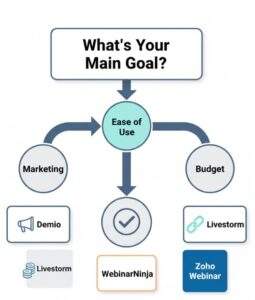The 5 Best Webinar Software for Small Business
Choosing the right webinar platform can feel like a high-stakes decision. You’re looking for a tool that’s powerful enough to generate leads and engage customers, yet simple enough that you don’t need an IT degree to run it. With countless options and confusing pricing tiers, it’s easy to feel stuck, fearing you’ll commit to a costly subscription that doesn’t deliver.
You’re in the right place. We’ve done the heavy lifting for you, researching and testing the top platforms to find the best webinar software for small business owners like you. This guide provides a clear, direct comparison to help you make a smart, confident decision for your company’s growth in 2025.
Quick Comparison: Top Webinar Platforms at a Glance
Before we dive deep, here’s a quick overview of our top 5 picks.
In-Depth Webinar Software Reviews for Small Businesses
Let’s explore what makes each of these platforms a strong contender for your small business.
1. Demio (Best for Marketers & Engagement)
Demio is built from the ground up for marketing. Its standout feature is that everything runs directly in the browser—no downloads required for you or your attendees. This removes a major friction point, leading to higher attendance rates.
The platform excels at interactive features like polls, Q&As, and featured actions (CTAs) that are designed to convert viewers into customers. It’s clean, modern, and focuses on making your brand look good.
- Pros:
- Extremely reliable, no-download experience for attendees.
- Powerful marketing tools and automations.
- Clean, professional, and customizable branding.
- Cons:
- Pricing can be higher than some competitors based on attendee limits.
- Fewer features for internal meetings compared to all-in-one tools.
- Pricing: Starts at $42/month for a 50-attendee room.
- Credibility Boost: “Users on Capterra consistently highlight its simplicity. One reviewer notes, ‘Demio is by far the easiest and most beautiful webinar software I’ve ever used. It just works.’”
2. Livestorm (Best All-in-One Event Platform)
Livestorm is more than just a webinar tool; it’s a complete video engagement platform. It’s perfect if you plan to host a variety of events, from live product demos and sales calls to pre-recorded, on-demand training sessions.
Its strength lies in automation and data. You can create automated webinar sequences, sync attendee data directly with your CRM (like HubSpot or Salesforce), and get detailed analytics on engagement.
- Pros:
- Excellent for live, on-demand, and automated webinars.
- Powerful native integrations with major CRMs and marketing tools.
- In-depth analytics to measure event ROI.
- Cons:
- The free plan is quite limited.
- Can have a slightly steeper learning curve than simpler tools.
- Pricing: Offers a limited free plan. Paid plans start at $79/month.
Spotlight Comparison: Livestorm vs Demio
When looking at a Livestorm vs Demio comparison, the choice comes down to your primary goal. Choose Demio if your main focus is on hosting live marketing webinars with maximum engagement and conversion tools. Choose Livestorm if you need a more versatile platform for various event types (live, automated, on-demand) and require deep data integration with your existing sales and marketing stack.
3. WebinarNinja (Best for Ease of Use & Beginners)
If the thought of a complex technical setup gives you a headache, WebinarNinja is your answer. Their promise is that you can create and schedule a webinar in under 60 seconds, and they deliver.
Despite its simplicity, it’s packed with features. It offers multiple formats (live, automated, series, hybrid), includes built-in landing pages and email reminders, and integrates with thousands of other apps via Zapier.
- Pros:
- Incredibly fast and intuitive setup process.
- All-in-one solution with pages, emails, and analytics included.
- Great value for the number of features provided.
- Cons:
- The user interface can feel slightly less modern than Demio or Livestorm.
- Pricing: Starts at $24/month for 25 live attendees.
- Credibility Boost: “On G2, a common sentiment is its user-friendliness. A small business owner said, ‘I love that I don’t have to be tech-savvy to use WebinarNinja. I set up my entire webinar series in one afternoon.’”
4. GetResponse (Best for Integrated Marketing Campaigns)
For small businesses that want one platform to manage email marketing, landing pages, and webinars, GetResponse is a powerhouse. The webinar functionality is built directly into its robust marketing automation suite.
This is the ideal choice if you already use or need an email marketing service. You can seamlessly promote your webinar to your email list, use automation to follow up with attendees and non-attendees, and manage the entire customer journey from one dashboard.
- Pros:
- Webinars are fully integrated with a complete marketing suite.
- Excellent for lead nurturing and sales funnel automation.
- Cost-effective, as you get many tools for one subscription price.
- Cons:
- The webinar feature itself may not be as deep as specialized platforms.
- You have to subscribe to a marketing plan to access it.
- Pricing: Webinar features are included in the “Email Marketing” plan, starting at $49/month for up to 100 attendees.
5. Zoho Webinar (Best for Budget-Conscious Businesses)
For businesses already using the Zoho ecosystem (CRM, Books, etc.) or those on a tighter budget, Zoho Webinar is an unbeatable value. It’s a straightforward, reliable platform that covers all the essentials without the hefty price tag.
You get core features like screen sharing, Q&As, polls, and basic reporting. While it may lack the polished feel of Demio, it is a workhorse that integrates perfectly with other Zoho products, creating a powerful, low-cost business management system.
- Pros:
- Very affordable pricing plans.
- Seamless integration with the extensive Zoho suite of apps.
- Reliable performance for core webinar functions.
- Cons:
- The interface is more functional than beautiful.
- Fewer advanced marketing and branding features.
- Pricing: Starts at $16/month for 25 attendees.
Considering Free Webinar Platforms for Your Small Business?
You might be wondering if you can get by with a free tool. Free webinar platforms for small business can be a great starting point for internal meetings or very small, informal presentations. Tools like Zoho Meeting’s free plan or Livestorm’s free tier give you a taste of the experience.
However, for professional, external-facing webinars, they often come with limitations: provider branding, strict time limits, very low attendee caps, and a lack of marketing features. To build brand credibility and effectively generate leads, investing in a paid plan is almost always worth it.
Final Verdict: Which Webinar Software Should You Choose?
There is no single “best” platform, only the one that’s best for your business. Here are our final recommendations based on your specific needs:
- Best for Absolute Beginners: WebinarNinja. Its 60-second setup is unbeatable, letting you focus on your content, not the tech.
- Best for Sales & Marketing Automation: Demio. Its browser-based simplicity and conversion-focused tools are designed to turn viewers into customers.
- Best for All-in-One Event Strategy: Livestorm. If you plan to use a mix of live, on-demand, and automated events and need deep CRM integration, this is your platform.
- Best on a Tight Budget: Zoho Webinar. It offers professional-grade features at a fraction of the cost of its competitors, especially if you use other Zoho apps.
Conclusion

Your webinar software is an investment in your business’s growth. By understanding your primary goals—whether it’s ease of use, marketing power, or budget-friendliness—you can confidently select a platform from this list. Stop letting the fear of choosing the wrong tool hold you back, and start connecting with your audience today.
Frequently Asked Questions (FAQ)
Q1: What’s the real difference between a webinar and a Zoom meeting?
A Zoom meeting is designed for collaboration, where all participants can talk and share their screens. A webinar is a one-to-many presentation format. The host and designated panelists present to a large, view-only audience, with interaction managed through moderated tools like Q&A, polls, and chat.
Q2: Are free webinar platforms good enough for a professional business?
For internal training or informal chats, yes. For marketing, lead generation, or building brand authority, a paid platform is highly recommended. Paid tools remove third-party branding, offer higher attendee limits, and provide the essential marketing and analytics features you need for a positive ROI.
Q3: What essential features should I look for in webinar software?
Look for a no-download, browser-based experience for attendees, automated email reminders, interactive tools (polls, Q&A), a call-to-action feature, and good analytics. Integration with your email marketing service or CRM is also crucial.
Q4: What are some quick tips on how to host a successful webinar?
Promote your event across multiple channels (email, social media). Rehearse your presentation and test your tech beforehand. Engage your audience with polls and a live Q&A session. Finally, always follow up with both attendees and non-attendees with a recording and a clear call to action.
Comprehensive Guide to Selecting Webinar Software for Small Businesses (2025).PDF
Hi, I’m [jeybee]. As a long-time resident of Seoul, I’m passionate about uncovering the authentic, everyday magic of Korea. This blog is my way of sharing my favorite spots, tips, and cultural insights with you, beyond the usual tourist traps.



